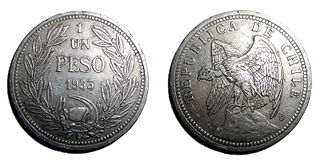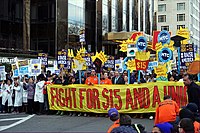A minimum wage is the lowest remuneration that employers can legally pay their employees—the price floor below which employees may not sell their labor. Most countries had introduced minimum wage legislation by the end of the 20th century. Because minimum wages increase the cost of labor, companies often try to avoid minimum wage laws by using gig workers, by moving labor to locations with lower or nonexistent minimum wages, or by automating job functions. Minimum wage policies can vary significantly between countries or even within a country, with different regions, sectors, or age groups having their own minimum wage rates. These variations are often influenced by factors such as the cost of living, regional economic conditions, and industry-specific factors.
In economics, stagflation or recession-inflation is a situation in which the inflation rate is high or increasing, the economic growth rate slows, and unemployment remains steadily high. It presents a dilemma for economic policy, since actions intended to lower inflation may exacerbate unemployment.

In economics, inflation is a general increase in the prices of goods and services in an economy. This is usually measured using the consumer price index (CPI). When the general price level rises, each unit of currency buys fewer goods and services; consequently, inflation corresponds to a reduction in the purchasing power of money. The opposite of CPI inflation is deflation, a decrease in the general price level of goods and services. The common measure of inflation is the inflation rate, the annualized percentage change in a general price index. As prices faced by households do not all increase at the same rate, the consumer price index (CPI) is often used for this purpose.

The Office of Price Administration (OPA) was established within the Office for Emergency Management of the United States government by Executive Order 8875 on August 28, 1941. The functions of the OPA were originally to control money and rents after the outbreak of World War II.

Rationing is the controlled distribution of scarce resources, goods, services, or an artificial restriction of demand. Rationing controls the size of the ration, which is one's allowed portion of the resources being distributed on a particular day or at a particular time. There are many forms of rationing, although rationing by price is most prevalent.

Economics in One Lesson is an introduction to economics written by Henry Hazlitt and first published in 1946. It is based on Frédéric Bastiat's essay Ce qu'on voit et ce qu'on ne voit pas.
Incomes policies in economics are economy-wide wage and price controls, most commonly instituted as a response to inflation, and usually seeking to establish wages and prices below free market level.
Labour power is the capacity to do work, a key concept used by Karl Marx in his critique of capitalist political economy. Marx distinguished between the capacity to do work, i.e. labour power, and the physical act of working, i.e. labour. Labour power exists in any kind of society, but on what terms it is traded or combined with means of production to produce goods and services has historically varied greatly.

A price ceiling is a government- or group-imposed price control, or limit, on how high a price is charged for a product, commodity, or service. Governments use price ceilings to protect consumers from conditions that could make commodities prohibitively expensive. Such conditions can occur during periods of high inflation, in the event of an investment bubble, or in the event of monopoly ownership of a product, all of which can cause problems if imposed for a long period without controlled rationing, leading to shortages. Further problems can occur if a government sets unrealistic price ceilings, causing business failures, stock crashes, or even economic crises. On the other hand, price ceilings give a government to the power to prevent corporations from price gouging or otherwise setting prices that create negative outcomes for the government's society.

A price floor is a government- or group-imposed price control or limit on how low a price can be charged for a product, good, commodity, or service. It is one type of price support; other types include supply regulation and guarantee government purchase price. A price floor must be higher than the equilibrium price in order to be effective. The equilibrium price, commonly called the "market price", is the price where economic forces such as supply and demand are balanced and in the absence of external influences the (equilibrium) values of economic variables will not change, often described as the point at which quantity demanded and quantity supplied are equal. Governments use price floors to keep certain prices from going too low.
The Balcerowicz Plan, also termed "Shock Therapy", was a method for rapidly transitioning from an economy based on state ownership and central planning, to a capitalist market economy. A group of experts, which they formed together with Balcerowicz, including Stanisław Gomułka, Stefan Kawalec and Wojciech Misiąg, in September 1989 created a reform plan based on an earlier idea of Jeffrey Sachs, and on October 6, an outline of this plan was presented to the public by Balcerowicz at a press conference broadcast by TVP.

In economics, a shortage or excess demand is a situation in which the demand for a product or service exceeds its supply in a market. It is the opposite of an excess supply (surplus).
A buffer stock scheme is an attempt to use commodity storage for the purposes of stabilising prices in an entire economy or an individual (commodity) market. Specifically, commodities are bought when a surplus exists in the economy, stored, and are then sold from these stores when economic shortages in the economy occur.
The Law of the General Maximum was instituted during the French Revolution on 29 September 1793, setting price limits and punishing price gouging to attempt to ensure the continued supply of food to the French capital. It was enacted as an extension of the Law of Suspects of 17 September, and succeeded the Law of the Maximum of 4 May 1793, which served a similar purpose.

The Vuskovic Plan was the basis for the economic policy of the Popular Unity (UP) government of Chilean President Salvador Allende. It was drafted by and named after his first Economics Minister Pedro Vuskovic, who had worked before with the CEPAL. Although good results were obtained in 1970, hyperinflation made a comeback in 1972. By 1973, Chile was in shambles – inflation was hundreds of percents, the country had no foreign reserves, and GDP was falling.
Disequilibrium macroeconomics is a tradition of research centered on the role of disequilibrium in economics. This approach is also known as non-Walrasian theory, equilibrium with rationing, the non-market clearing approach, and non-tâtonnement theory. Early work in the area was done by Don Patinkin, Robert W. Clower, and Axel Leijonhufvud. Their work was formalized into general disequilibrium models, which were very influential in the 1970s. American economists had mostly abandoned these models by the late 1970s, but French economists continued work in the tradition and developed fixprice models.

In the 1980s, severe austerity measures were imposed in the Socialist Republic of Romania by President Nicolae Ceaușescu in order to pay out the external debt incurred by the state in the 1970s. Beginning in 1981, the austerity led to economic stagnation that continued all throughout the 1980s, a "sui generis shock therapy" which lowered the competitiveness of the Romanian economy and decreased the amount of exports.

When elected in 2013, Nicolás Maduro continued the majority of existing economic policies of his predecessor Hugo Chávez. When entering the presidency, President Maduro's Venezuela faced a high inflation rate and large shortages of goods that was left over from the previous policies of President Chávez. These economic difficulties that Venezuela was facing were one of the main reasons of the current protests in Venezuela. President Maduro has blamed capitalism for speculation that is driving high rates of inflation and creating widespread shortages of staples, and often said he was fighting an "economic war", calling newly enacted economic measures "economic offensives" against political opponents he and loyalists state are behind an international economic conspiracy. However, President Maduro has been criticized for only concentrating on public opinion instead of tending to the practical issues economists have warned the Venezuelan government about or creating any ideas to improve the economic situation in Venezuela such as the "economic war".
This glossary of economics is a list of definitions of terms and concepts used in economics, its sub-disciplines, and related fields.
The National Superintendence for the Defense of Socioeconomic Rights, abbreviated as SUNDDE, is a Venezuelan governmental organization. Established in 2014, the organization is tasked with the management of price controls and enforcing business compliance with government regulations.














